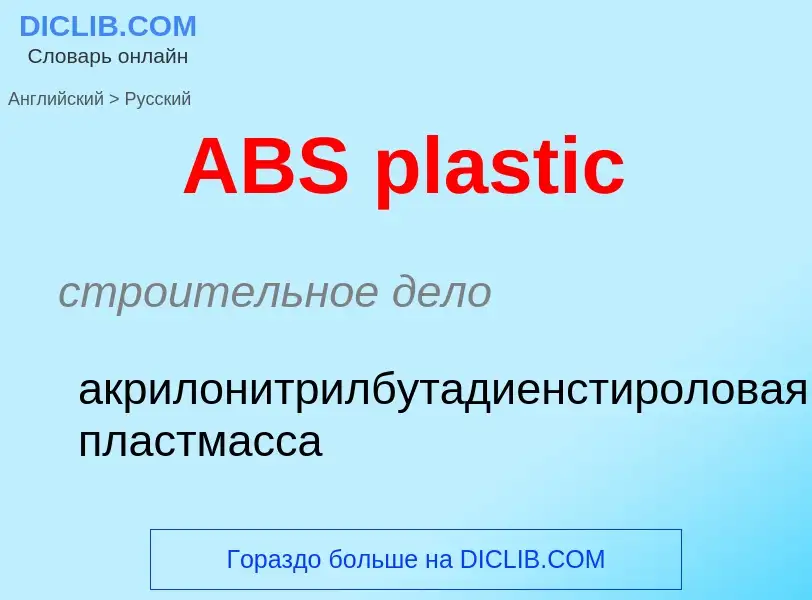Перевод и анализ слов искусственным интеллектом
На этой странице Вы можете получить подробный анализ слова или словосочетания, произведенный с помощью лучшей на сегодняшний день технологии искусственного интеллекта:
- как употребляется слово
- частота употребления
- используется оно чаще в устной или письменной речи
- варианты перевода слова
- примеры употребления (несколько фраз с переводом)
- этимология
ABS plastic - перевод на русский
строительное дело
акрилонитрилбутадиенстироловая пластмасса
общая лексика
от Absolute
в языках программирования - функция, возвращающая абсолютное значение числа. Так, ABS(-3) равно 3
сокращение
antilock braking system
[American Bureau of Standards] Американское бюро стандартов
Смотрите также
существительное
общая лексика
радиовещательная компания "Америкэн бродкастинг систем"
синоним
Определение
Википедия
Acrylonitrile butadiene styrene (ABS) (chemical formula (C8H8)x·(C4H6)y·(C3H3N)z ) is a common thermoplastic polymer. Its glass transition temperature is approximately 105 °C (221 °F). ABS is amorphous and therefore has no true melting point.
ABS is a terpolymer made by polymerizing styrene and acrylonitrile in the presence of polybutadiene. The proportions can vary from 15% to 35% acrylonitrile, 5% to 30% butadiene and 40% to 60% styrene. The result is a long chain of polybutadiene crisscrossed with shorter chains of poly(styrene-co-acrylonitrile). The nitrile groups from neighboring chains, being polar, attract each other and bind the chains together, making ABS stronger than pure polystyrene. The acrylonitrile also contributes chemical resistance, fatigue resistance, hardness, and rigidity, while increasing the heat deflection temperature. The styrene gives the plastic a shiny, impervious surface, as well as hardness, rigidity, and improved processing ease. The polybutadiene, a rubbery substance, provides toughness and ductility at low temperatures, at the cost of heat resistance and rigidity. For the majority of applications, ABS can be used between −20 and 80 °C (−4 and 176 °F), as its mechanical properties vary with temperature. The properties are created by rubber toughening, where fine particles of elastomer are distributed throughout the rigid matrix.

![3D printer]] 3D printer]]](https://commons.wikimedia.org/wiki/Special:FilePath/ABS Printed Bell on Makerbot ThingOMatic.jpg?width=200)

![Police outside [[Eden Park]] prior to a New Zealand match during the [[1981 Springbok tour]] Police outside [[Eden Park]] prior to a New Zealand match during the [[1981 Springbok tour]]](https://commons.wikimedia.org/wiki/Special:FilePath/1981-springbok-tour-auckland-entry-to-ground.jpg?width=200)
![Twickenham]] in 2006 Twickenham]] in 2006](https://commons.wikimedia.org/wiki/Special:FilePath/All Blacks England.jpg?width=200)
![France]] in November 2006 France]] in November 2006](https://commons.wikimedia.org/wiki/Special:FilePath/All Blacks Haka.jpg?width=200)
![Australia]] Australia]]](https://commons.wikimedia.org/wiki/Special:FilePath/Allblacks haka 1932.jpg?width=200)
![1985 tour of Argentina]] 1985 tour of Argentina]]](https://commons.wikimedia.org/wiki/Special:FilePath/Argentina vs all blacks reid running.jpg?width=200)
![[[Colin Meads]] (here pictured in 1956), New Zealand's player of the century [[Colin Meads]] (here pictured in 1956), New Zealand's player of the century](https://commons.wikimedia.org/wiki/Special:FilePath/Colin Meads.jpg?width=200)
![Original All Blacks]]" that toured the United Kingdom in 1905, [[Dave Gallaher]] is an inductee into the [[World Rugby Hall of Fame]] Original All Blacks]]" that toured the United Kingdom in 1905, [[Dave Gallaher]] is an inductee into the [[World Rugby Hall of Fame]]](https://commons.wikimedia.org/wiki/Special:FilePath/Dave Gallaher.jpg?width=200)
![[[Jonah Lomu]] debuted with New Zealand at 19 years old. He is generally regarded as the first true global superstar of rugby union [[Jonah Lomu]] debuted with New Zealand at 19 years old. He is generally regarded as the first true global superstar of rugby union](https://commons.wikimedia.org/wiki/Special:FilePath/Mardel 24-1-01 lomu en villa marista foto fabian gastiarena.jpg?width=200)

![[[The Original All Blacks]] that toured the British Isles, France and the United States during 1905–06. The team won 34 of their 35 tour matches. [[The Original All Blacks]] that toured the British Isles, France and the United States during 1905–06. The team won 34 of their 35 tour matches.](https://commons.wikimedia.org/wiki/Special:FilePath/Original allblacks.jpg?width=200)
![[[Richie McCaw]] is the second most capped rugby player of all time after [[Alun Wyn Jones]], and was the first New Zealander to play 100 test matches [[Richie McCaw]] is the second most capped rugby player of all time after [[Alun Wyn Jones]], and was the first New Zealander to play 100 test matches](https://commons.wikimedia.org/wiki/Special:FilePath/Rugby world cup 2011 NEW ZEALAND ARGENTINA (7309681452).jpg?width=200)
